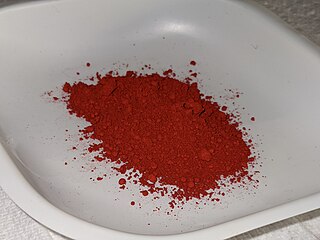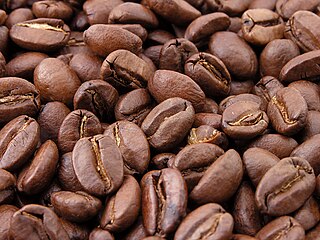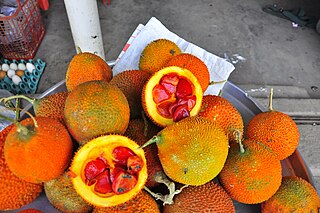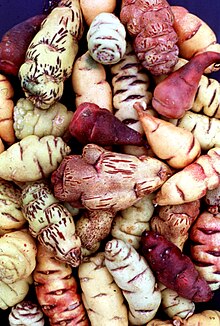
The potato is a starchy root vegetable native to the Americas that is consumed as a staple food in many parts of the world. Potatoes are tubers of the plant Solanum tuberosum, a perennial in the nightshade family Solanaceae.

Pantothenic acid (vitamin B5) is a B vitamin and an essential nutrient. All animals need pantothenic acid in order to synthesize coenzyme A (CoA)—essential for metabolizing fatty acid—and to synthesize and metabolize proteins, carbohydrates, and fats.

Vitamin A is a fat-soluble vitamin and an essential nutrient for animals. The term "vitamin A" encompasses a group of chemically related organic compounds that includes retinol, retinal, retinoic acid, and several provitamin (precursor) carotenoids, most notably beta-carotene. Vitamin A has multiple functions: it is essential for embryo development and growth, for maintenance of the immune system, and for vision, where it combines with the protein opsin to form rhodopsin – the light-absorbing molecule necessary for both low-light and color vision.

Tropaeolum, commonly known as nasturtium, is a genus of roughly 80 species of annual and perennial herbaceous flowering plants. It was named by Carl Linnaeus in his book Species Plantarum, and is the only genus in the family Tropaeolaceae. The nasturtiums received their common name because they produce an oil similar to that of watercress.
A nutrient is a substance used by an organism to survive, grow, and reproduce. The requirement for dietary nutrient intake applies to animals, plants, fungi, and protists. Nutrients can be incorporated into cells for metabolic purposes or excreted by cells to create non-cellular structures, such as hair, scales, feathers, or exoskeletons. Some nutrients can be metabolically converted to smaller molecules in the process of releasing energy, such as for carbohydrates, lipids, proteins, and fermentation products, leading to end-products of water and carbon dioxide. All organisms require water. Essential nutrients for animals are the energy sources, some of the amino acids that are combined to create proteins, a subset of fatty acids, vitamins and certain minerals. Plants require more diverse minerals absorbed through roots, plus carbon dioxide and oxygen absorbed through leaves. Fungi live on dead or living organic matter and meet nutrient needs from their host.

Sprouting is the natural process by which seeds or spores germinate and put out shoots, and already established plants produce new leaves or buds, or other structures experience further growth.

Oxalis tuberosa is a perennial herbaceous plant that overwinters as underground stem tubers. These tubers are known as uqa in Quechua, oca in Spanish, yams in New Zealand and a number of other alternative names. The plant was brought into cultivation in the central and southern Andes for its tubers, which are used as a root vegetable. The plant is not known in the wild, but populations of wild Oxalis species that bear smaller tubers are known from four areas of the central Andean region. Oca was introduced to Europe in 1830 as a competitor to the potato, and to New Zealand as early as 1860.

β-Carotene (beta-carotene) is an organic, strongly coloured red-orange pigment abundant in fungi, plants, and fruits. It is a member of the carotenes, which are terpenoids (isoprenoids), synthesized biochemically from eight isoprene units and thus having 40 carbons. Among the carotenes, β-carotene is distinguished by having beta-rings at both ends of the molecule. β-Carotene is biosynthesized from geranylgeranyl pyrophosphate.

Ullucus is a genus of flowering plants in the family Basellaceae, with one species, Ullucus tuberosus, a plant grown primarily as a root vegetable, secondarily as a leaf vegetable. The name ulluco is derived from the Quechua word ulluku, but depending on the region, it has many different names. These include illaco, melloco, chungua or ruba, olluco or papalisa, or ulluma.

Solanine is a glycoalkaloid poison found in species of the nightshade family within the genus Solanum, such as the potato, the tomato, and the eggplant. It can occur naturally in any part of the plant, including the leaves, fruit, and tubers. Solanine has pesticidal properties, and it is one of the plant's natural defenses. Solanine was first isolated in 1820 from the berries of the European black nightshade, after which it was named. It belongs to the chemical family of saponins.

Cat food is food specifically designed for consumption by cats. As obligate carnivores, cats have specific requirements for their dietary nutrients, namely nutrients found only in meat, such as taurine, arginine, and Vitamin B6. Certain nutrients, including many vitamins and amino acids, are degraded by the temperatures, pressures and chemical treatments used during manufacture, and hence must be added after manufacture to avoid nutritional deficiency.
The Age-Related Eye Disease Study (AREDS) was a clinical trial sponsored by the National Eye Institute that ran from 1992–2001. The study was designed to:

A coffee bean is a fruit from the Coffea plant and the source for coffee. It is the pip inside the red or purple fruit. This fruit is often referred to as a coffee cherry, and like the cherry, it is a stone fruit. Even though the coffee beans are not technically beans, they are referred to as such because of their resemblance to true beans. The fruits most commonly contain two stones with their flat sides together. A small percentage of cherries contain a single seed, instead of the usual two, called a "peaberry". The peaberry occurs only between 10% and 15% of the time, and it is a fairly common belief that they have more flavour than normal coffee beans. Like Brazil nuts and white rice, coffee beans consist mostly of endosperm.

Docosahexaenoic acid (DHA) is an omega-3 fatty acid that is a primary structural component of the human brain, cerebral cortex, skin, and retina. In physiological literature, it is given the name 22:6(n-3). It can be synthesized from alpha-linolenic acid or obtained directly from maternal milk, fatty fish, fish oil, or algae oil.

Apios americana, sometimes called the American groundnut, potato bean, hopniss, Indian potato, hodoimo, America-hodoimo, cinnamon vine, or groundnut is a perennial vine that bears edible beans and large edible tubers.

Lutein is a xanthophyll and one of 600 known naturally occurring carotenoids. Lutein is synthesized only by plants, and like other xanthophylls is found in high quantities in green leafy vegetables such as spinach, kale and yellow carrots. In green plants, xanthophylls act to modulate light energy and serve as non-photochemical quenching agents to deal with triplet chlorophyll, an excited form of chlorophyll which is overproduced at very high light levels during photosynthesis. See xanthophyll cycle for this topic.

Gấc [IPA ɣək̚˧˦] is a type of perennial melon grown throughout Southeast Asian countries and Northeastern Australia. Gấc is notable for its vivid orange-reddish color resulting from its rich content of beta-carotene and lycopene.

Senior dog food diets are pet foods that are catered toward the senior or mature pet population. The senior dog population consists of dogs that are over the age of seven for most dog breeds, though in general large and giant breed dogs tend to reach this life stage earlier when compared to smaller breed dogs. Senior dog foods contain nutrients and characteristics that are used to improve the health of the aging dog. Aging in dogs causes many changes to occur physiologically that will require a change in nutrient composition of their diet.
In general, cognitive support diets are formulated to include nutrients that have a known role in brain development, function and/or maintenance, with the goal of improving and preserving mental processes such as attentiveness, short-term and long-term memory, learning, and problem solving. Currently, there is very little conclusive research available regarding cat cognition as standardized tests for evaluating cognitive ability are less established and less reliable than cognitive testing apparatus used in other mammalian species, like dogs. Much of what is known about feline cognition has been inferred from a combination of owner-reported behaviour, brain necropsies, and comparative cognitive neurology of related animal models. Cognition claims appear primarily on kitten diets which include elevated levels of nutrients associated with optimal brain development, although there are now diets available for senior cats that include nutrients to help slow the progression of age-related changes and prevent cognitive decline. Cognition diets for cats contain a greater portion of omega-3 fatty acids, especially docosahexaenoic acid (DHA) as well as eicosapentaenoic acid (EPA), and usually feature a variety of antioxidants and other supporting nutrients thought to have positive effects on cognition.

As in the human practice of veganism, vegan dog foods are those formulated with the exclusion of ingredients that contain or were processed with any part of an animal, or any animal byproduct. Vegan dog food may incorporate the use of fruits, vegetables, cereals, legumes including soya, nuts, vegetable oils, as well as any other non-animal based foods.



















